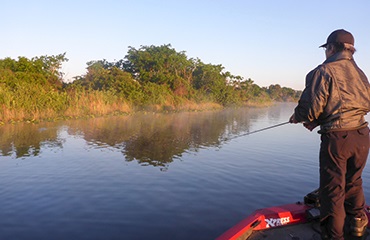 Hiro Naito rarely unleashes a really long cast. He believes long casts and retrieves keep the lure in low-percentage areas too much of the time and leave too much to chance. A fishing industry veteran and legendary bass angler, Naito isn’t content to wait for a bass to take his lure. He’s invariably intentional about making fish bite and maximizing the time his lure stays the strike zone.
Hiro Naito rarely unleashes a really long cast. He believes long casts and retrieves keep the lure in low-percentage areas too much of the time and leave too much to chance. A fishing industry veteran and legendary bass angler, Naito isn’t content to wait for a bass to take his lure. He’s invariably intentional about making fish bite and maximizing the time his lure stays the strike zone.
Execution of Naito’s philosophy involves many elements, such as identifying high percentage zones or spots and creating different sounds and actions with his lure to trigger attacks. A critical aspect, though, is to keep the lure where bass are the most likely to be positioned and to bite, and for the types of fishing Naito chooses to do, that usually involves positioning his boat fairly close to key areas and making short casts to specific targets.
Working close allows Naito to be extremely accurate with casts. Whether he’s working a weedy shoreline, fishing cover that’s off the bank or cranking a submerged weed edge, Naito always knows the specific spot he wants to work with a cast. If that spot is a weed cut that’s tight to the bank, he wants to land a soft cast in the absolute back of that cut. If it’s a point along big slanting laydown branch, he wants to cast just far enough past the key spot to make a quality presentation over that spot. If he’s cranking submerged cover, he casts just far enough past the key zone to get his crankbait down to hit that spot. In any situation, the sort of accuracy Naito seeks is tough to attain from farther away.
As importantly, once Naito has worked his lure through what he considers the likely productive area, he always reels it back quickly and immediately casts to the next target he has selected.
“Making a long cast and working the lure all the way back keeps the lure in unproductive water too much of the time,” Naito said. “I want my lure where the fish are so I have the highest percentage chance to make fish bite.”
Finally, working closer to the lure allows for better control over the lure and over the fish when one bites. Naito can work his lures more effectively to create specific sounds and movements with less line between him and the lure. When fish do strike, being close to the action usually translates into quicker and more effective hooksets and better control of a fish to get it turned away from the cover and toward the boat.
It’s worth noting that “short” is a relative term, and Naito’s average cast length and boat positioning certainly vary based on his lure choice, the nature of the cover and other factors. As a general rule, though, he stays at the short end of the spectrum for casts and is confident that results in him catching more fish.

